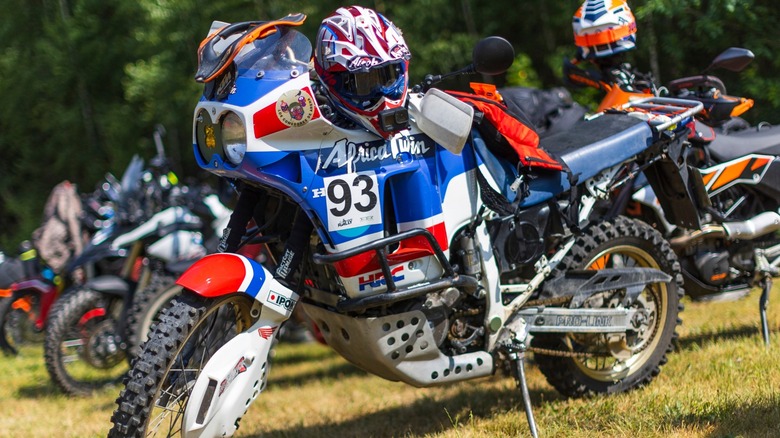Every Generation Of The Honda Africa Twin Ranked
Over the years, the Africa Twin has undergone significant transformations, reflecting advancements in technology, design, and rider preferences. So, in this article, we are going to explore, evaluate, and rank each generation, considering key criteria such as performance, technological improvements, evolving features, historical significance, and overall value. In its nascent years, the Africa Twin was hailed for its simplicity — it actually garnered a reputation as a dependable bike for long-distance journeys and off-road adventures. As time progressed, so did the bike, incorporating advanced technologies and design enhancements that brought it in line with more modern expectations.
The criteria for ranking each generation have drawn insights from extensive research and reviews from reliable sources for motorcycle information like Visor Down and MCN. Official Honda documentation also provided valuable insights, while reviews from reputed outlets and trusted enthusiasts and riders contributed to a comprehensive perspective.
This ranking aims to provide a nuanced understanding of how the Africa Twin has evolved, acknowledging the strengths and improvements introduced with each iteration. By considering multifaceted aspects like performance, features, and historical value mentioned earlier, enthusiasts and riders get to appreciate the legacy of the Honda Africa Twin across its diverse generations even better. So, here is every generation of the Honda African Twin, ranked.
4. XRV750T (1990 - 2003)
The second generation of the Honda Africa Twin, known as the XRV750T, is a good bike but not as impressive compared to what other generations have brought to the table. With a 742 cc liquid-cooled 52-degree V-twin engine, the XRV750T delivered a balanced 61 bhp at 7,500 rpm and 62 Nm of torque at 6,500 rpm. It isn't very groundbreaking in terms of raw power, but then again, the Africa Twin of this era was more about torque, especially in the sweet spot between 3,000 and 5,000 rpm. It had distinctive Dakar-inspired styling, including the iconic twin headlights and the muscular 23-liter tank.
Whether navigating the open road or tackling off-road trails, the bike's design, with a seat height of 33.9 inches and a weight of 456 pounds (dry), allowed for a good experience either way. Even with the incremental upgrades, the bike's popularity soared through the mid-'90s, prompting Honda to give it a final major redesign in 1993. This redesign, with a new frame and a wider, taller profile. Despite its success, the Africa Twin faced a decline in popularity as the new millennium approached. In 2001, Honda ceased production of the XRV750T after selling 73,000 units — and thus began the hiatus.
3. CRF1100L (2020 - present)
The Honda Africa Twin, as you can tell by now, has a storied legacy, evolving through various generations to become the versatile dual-sport machine we know today — which brings us to the fourth and current generation that began in 2020 and represented by the Honda Africa Twin CRF1100L.
After the CRF1000L in 2016, Honda upgraded the model in 2018, introducing three new riding modes, improved intake and exhaust tuning, and an enhanced Honda Selectable Torque Control (HSTC) system. The Adventure Sports variant also added features like improved wind protection, extended tank range, and longer suspension travel, catering to off-road enthusiasts. The 2020 Honda CRF1100L Africa Twin improved the bike even further. The 998 cc parallel-twin engine was replaced with a 1,084 cc unit, delivering 101 bhp and 105 Nm of torque. The redesign also brought a slimmer and lighter profile, thanks to a new frame and swingarm design inspired by the CRF450. Technological advancements included a six-axis Inertial Measurement Unit (IMU), TFT touchscreen, Apple CarPlay, and Bluetooth Connectivity.
Notable improvements were made in off-road capabilities, as well, with a six-axis IMU aiding in various riding modes such as Off-road, Tour, Urban, and Gravel. The addition of user-customizable modes and wheelie control further enhanced the bike's adaptability to diverse riding conditions. With an 18.8-liter fuel tank capacity, this Adventure Sports variant was great news for all the off-road enthusiasts, but it did justice to on-road comfort, too.
2. CRF1000L (2016 - 2019)
The third generation of the Honda Africa Twin, the CRF1000L (2016-2019), marks the return of the legendary adventure bike after a hiatus that lasted more than a decade. It started in 2003, and it belongs in second rank because, even after 13 years, honda introduced a much better bike. The CRF1000L Africa Twin balanced comfort, agility, and off-road capability, and the bike immediately stands out with its ability to handle off-roads with ease.
The bike's design pays homage to the original Africa Twin but incorporates Honda's latest technical philosophy. On that note, a standout feature of the CRF1000L Africa Twin is the DCT twin-clutch transmission. With four mode settings for various parameters, including traction control and power delivery, the DCT can change the way you ride this bike. The CRF1000L Africa Twin also comes in two versions because of DCT — one with the DCT automatic gearbox priced at $14,200 and a manual option at $13,500.
On the road, the Africa Twin proves to be a capable and comfortable touring companion, too, which shouldn't be surprising since the bike is powered by a 1,000 cc, 94 bhp inline twin-cylinder motor. The riding position is upright, with wide bars reminiscent of the original Africa Twin. In off-road conditions, the Africa Twin proves impressive, too. The DCT version, in particular, transforms the off-road riding experience.
1. XRV650 (1988 - 1989)
The first generation of the Honda Africa Twin, represented by the XRV650 model produced between 1988 and 1989, ranks first in the list for kicking off the evolution of what is arguably one of the coolest adventure motorbikes on the market right now. Inspired by the success of the NXR750 in the Dakar Rally, Honda sought to replicate the rugged prowess of desert racers in a bike accessible to a broader audience — and the Africa Twin was born. Built closely to the specifications of the NXR750, it featured distinctive mesh headlights, twin aluminum radiators, a stainless steel exhaust, a stone guard, and quick-release fairings. The iconic HRC 'Tricolore' paint scheme further emphasized its racing pedigree.
Powered by a V-Twin engine, the XRV650 delivered ample torque and power for both on and off-road adventures. While its top speed exceeded 100 mph, the bike was great at providing low-end grunt for challenging terrains. The chassis of the XRV650, derived from the Rally NXR, had precision handling and a rigid build. Weighing in at 408 pounds dry, it maintained a reasonable weight despite off-road accessories like a sump guard. The Showa front forks and mono-shock rear suspension ensured adept off-road capabilities.
The bike was by no means perfect — notable issues with the early Africa Twins included CDI damage in the XRV650. Despite challenges, the bikes earned a great reputation and ended up being one of the best automatic transmission motorcycles you can buy right now, too.




